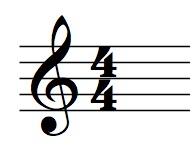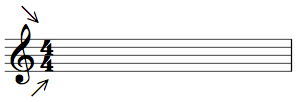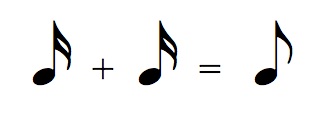Organising notes
Now that we know the names of the notes & rests, we need to know how to organise them, so that they can be easily read while playing an instrument.
First of all, we write notes on a series of 5 lines called a staff.
 When we have more than 1 staff, we call them staves.
When we have more than 1 staff, we call them staves.

When we write notes on a staff we have to organise them in small sections so that they are easier to follow.
We do this by placing them into bars (or measures).

Bars are created by drawing a line on the staff, called a barline. The barline is drawn from the top of the staff to the bottom of the staff.
We also have to show how many beats will occur in every bar. To do this, we use a time signature which is placed at the start of the piece.

The top number shows how many beats will occur in the bar.

The bottom note shows what type of note will be used to represent the beat. Note that there is no diagonal line between these numbers e.g. 4/4
It is not written as a fraction!
So in the above example, 4 beats will occur in every bar and each beat will be for the duration of a crotchet.
That means that every bar must have a combination of notes that together will add up to have the same duration as 4 crotchets. This is when music can become mathematical and you will need to understand fractions to be able to work it out.
For example, lets look at the “musical equations” below:
![]() 1/4 + 1/4 = 1/2
1/4 + 1/4 = 1/2
Quarter note (crotchet) + quarter note = half note (minim)
![]() 1/8 + 1/8 = 1/4
1/8 + 1/8 = 1/4
Eighth note (quaver) + eighth note = quarter note (crotchet)
 1/16 + 1/16 = 1/8
1/16 + 1/16 = 1/8
Sixteenth note (semi-quaver) + sixteenth note = eighth note (quaver)
Simple time
When the time signature uses single crotchet beats, it is referred to as simple time. There are a number of time signatures that fall into this category. For example:

This means that each bar will have either 2, 3 or 4 crotchet beats, depending on which time signature is used.
